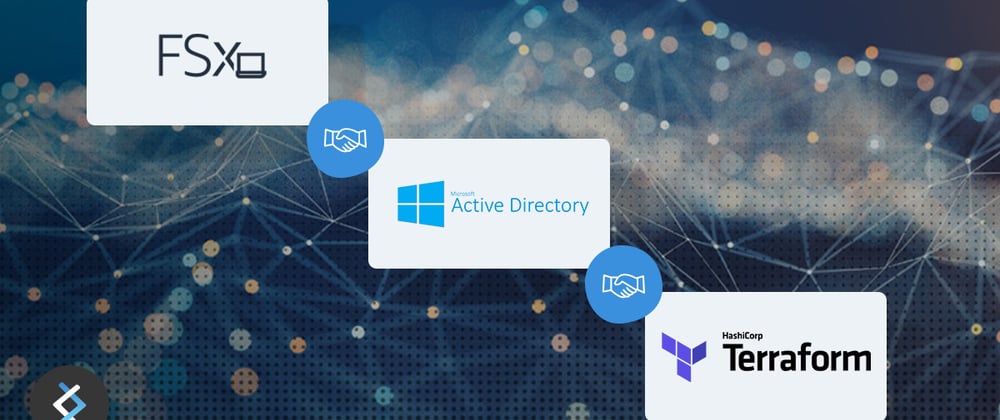TL;DR:
The github repo with all scripts are here.
Because of specific requirements, reasons, or preferences, some customers need to self-manage a Microsoft AD directory on-premises or in the cloud.
AWS offers options to have their fully managed Microsoft Windows file servers (Amazon FSx for Windows File Server) join a self-managed Microsoft Active Directory.
In this post, I will provide an example of launching an FSx for Windows File Server and joining a self-managed domain using Terraform.
This article won’t go into details on the following items as they are presumed to already be created.
Requirements:
- self-managed Microsoft AD directory
- the fully qualified, distinguished name (FQDN) of the organisational unit (OU) within your self-managed AD directory that the Windows File Server instance will join; and
- valid DNS servers and networking configuration (VPC/Subnets) that allows traffic from the file system to the domain controller.
In addition, I recommend to go through the steps “Validating your Active Directory configuration” from AWS Documentation at the following link to validate self-managed AD configuration before starting creation of the FSx filesystem:
On the file _variables.tf, we will provide the details for the self-managed AD, including IPs, DNS Name, Organisational Unit, and Domain Username and Password:
_variables.tf
variable "ad_directory_name" {
type = string
default = "example.com"
}
variable "ad_directory_ip1" {
type = string
default = "XXX.XXX.XXX.XXX"
}
variable "ad_directory_ip2" {
type = string
default = "XXX.XXX.XXX.XXX"
}
variable "fsx_name" {
type = string
default = "fsxblogpost"
}
variable "domain_ou_path" {
type = string
default = "OU=Domain Controllers,DC=example,DC=com"
}
variable "domain_fsx_username" {
type = string
default = "fsx"
}
variable "domain_fsx_password" {
type = string
default = "placeholder"
}
variable "fsx_deployment_type" {
type = string
default = "SINGLE_AZ_1"
}
variable "fsx_subnet_ids" {
type = list(string)
default = ["subnet-XXXXXXXXXXXX"]
}
variable "vpc_id" {
type = string
default = "vpc-XXXXXXXXXXXX"
}
variable "fsx_deployment_type" {
type = string
default = "SINGLE_AZ_1"
}
variable "fsx_subnet_ids" {
type = list(string)
default = ["subnet-XXXXXXXXXXXX"]
}
variable "vpc_id" {
type = string
default = "vpc-XXXXXXXXXXXX"
}
The file fsx.tf is where we will effectively create FSx filesystem, and also KMS encryption key and KMS Key policy. The KMS key is optional, however I strongly recommend having the filesystem encrypted.
fsx.tf
data "aws_iam_policy_document" "fsx_kms" {
statement {
sid = "Allow FSx to encrypt storage"
actions = ["kms:GenerateDataKey"]
resources = ["*"]
principals {
type = "Service"
identifiers = ["fsx.amazonaws.com"]
}
}
statement {
sid = "Allow account to manage key"
actions = ["kms:*"]
resources = ["arn:aws:kms:${data.aws_region.current.name}:${data.aws_caller_identity.current.account_id}:key/*"]
principals {
type = "AWS"
identifiers = ["arn:aws:iam::${data.aws_caller_identity.current.account_id}:root"]
}
}
}
resource "aws_kms_key" "fsx" {
description = "FSx Key"
deletion_window_in_days = 7
policy = data.aws_iam_policy_document.fsx_kms.json
}
resource "aws_fsx_windows_file_system" "fsx" {
kms_key_id = aws_kms_key.fsx.arn
storage_capacity = 100
subnet_ids = var.fsx_subnet_ids
throughput_capacity = 32
security_group_ids = [aws_security_group.fsx_sg.id]
deployment_type = var.fsx_deployment_type
self_managed_active_directory {
dns_ips = [var.ad_directory_ip1, var.ad_directory_ip2]
domain_name = var.ad_directory_name
username = var.domain_fsx_username
password = var.domain_fsx_password
organizational_unit_distinguished_name = var.domain_ou_path
}
}
resource "aws_security_group" "fsx_sg" {
name = "${var.fsx_name}-fsx-sg"
description = "SG for FSx"
vpc_id = data.aws_vpc.selected.id
tags = {
Name = "${var.fsx_name}-fsx-sg"
}
}
resource "aws_security_group_rule" "fsx_default_egress" {
description = "Traffic to internet"
type = "egress"
from_port = 0
to_port = 0
protocol = "-1"
security_group_id = aws_security_group.fsx_sg.id
cidr_blocks = ["0.0.0.0/0"]
}
resource "aws_security_group_rule" "fsx_access_from_vpc" {
type = "ingress"data "aws_iam_policy_document" "fsx_kms" {
statement {
sid = "Allow FSx to encrypt storage"
actions = ["kms:GenerateDataKey"]
resources = ["*"]
principals {
type = "Service"
identifiers = ["fsx.amazonaws.com"]
}
}
statement {
sid = "Allow account to manage key"
actions = ["kms:*"]
resources = ["arn:aws:kms:${data.aws_region.current.name}:${data.aws_caller_identity.current.account_id}:key/*"]
principals {
type = "AWS"
identifiers = ["arn:aws:iam::${data.aws_caller_identity.current.account_id}:root"]
}
}
}
resource "aws_kms_key" "fsx" {
description = "FSx Key"
deletion_window_in_days = 7
policy = data.aws_iam_policy_document.fsx_kms.json
}
resource "aws_fsx_windows_file_system" "fsx" {
kms_key_id = aws_kms_key.fsx.arn
storage_capacity = 100
subnet_ids = var.fsx_subnet_ids
throughput_capacity = 32
security_group_ids = [aws_security_group.fsx_sg.id]
deployment_type = var.fsx_deployment_type
self_managed_active_directory {
dns_ips = [var.ad_directory_ip1, var.ad_directory_ip2]
domain_name = var.ad_directory_name
username = var.domain_fsx_username
password = var.domain_fsx_password
organizational_unit_distinguished_name = var.domain_ou_path
}
}
resource "aws_security_group" "fsx_sg" {
name = "${var.fsx_name}-fsx-sg"
description = "SG for FSx"
vpc_id = data.aws_vpc.selected.id
tags = {
Name = "-${var.fsx_name}-fsx-sg"
}
}
resource "aws_security_group_rule" "fsx_default_egress" {
description = "Traffic to internet"
type = "egress"
from_port = 0
to_port = 0
protocol = "-1"
security_group_id = aws_security_group.fsx_sg.id
cidr_blocks = ["0.0.0.0/0"]
}
resource "aws_security_group_rule" "fsx_access_from_vpc" {
type = "ingress"
from_port = 0
to_port = 0
protocol = "-1"
security_group_id = aws_security_group.fsx_sg.id
cidr_blocks = [data.aws_vpc.selected.cidr_block]
}
from_port = 0
to_port = 0
protocol = "-1"
security_group_id = aws_security_group.fsx_sg.id
cidr_blocks = [data.aws_vpc.selected.cidr_block]
}
Once you apply the scripts on Terraform, it should take around 15 minutes for the resources to be created:
aws_fsx_windows_file_system.fsx: Creation complete after 15m54s [id=fs-05701e8e6ad3fbe24]
Apply complete! Resources: 5 added, 0 changed, 0 destroyed.
You should see the FSx created and in Available state on AWS Console, which means FSx was able to join the self-managed domain:
Conclusion
I hope the instructions and terraform scripts provided can make your life easier when launching FSx for Windows File Server and joining a self-managed domain using Terraform.
When recently working on a project, I noticed there weren’t many examples online, so I decided to write this blog post to help others.
I would encourage you to open an issue or feature request on the github repo in case you need any additional help when using the scripts.








Latest comments (0)